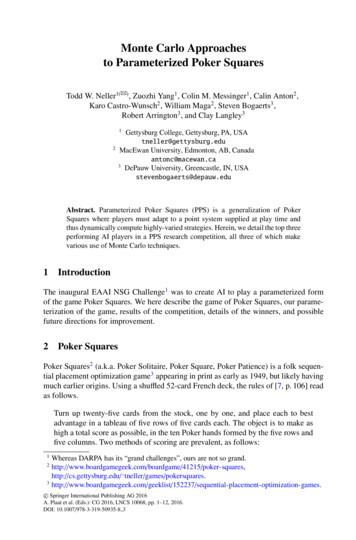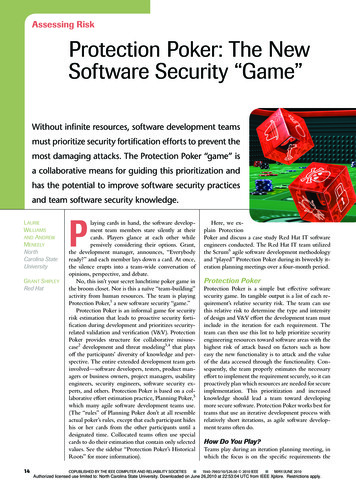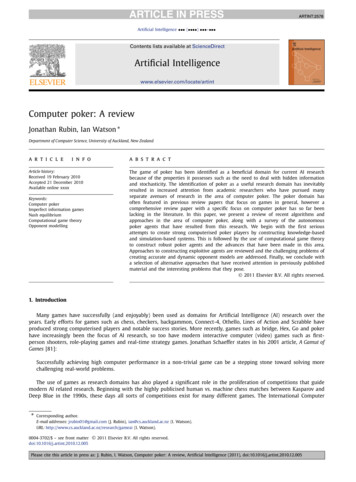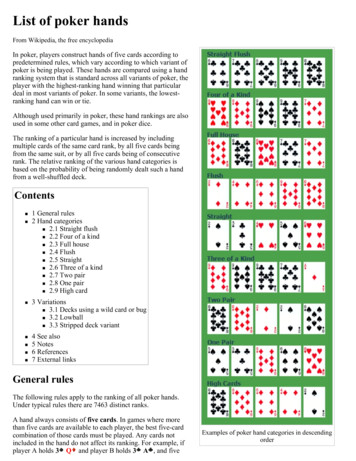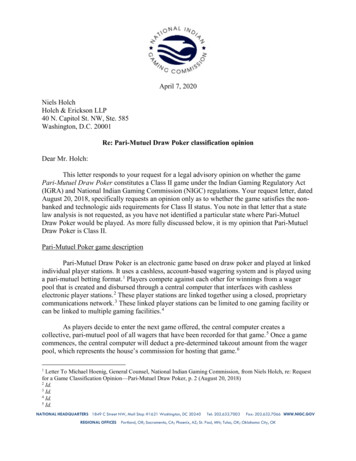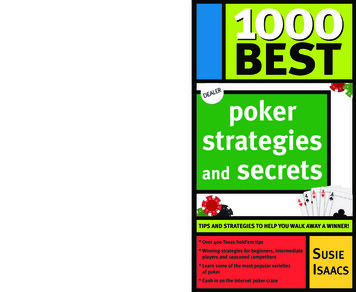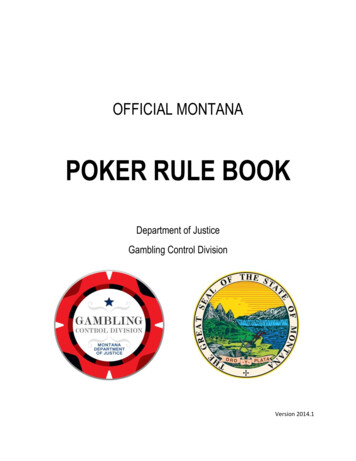
Transcription
OFFICIAL MONTANAPOKER RULE BOOKDepartment of JusticeGambling Control DivisionVersion 2014.1
ACKNOWLEDGEMENT AND ATTRIBUTIONThe Montana Department of Justice wishes to thank and acknowledge the work andcooperation of Mr. Bob Ciaffone, the author of “Robert’s Rules of Poker,” upon which theOfficial Montana Poker Rule Book is largely based. Mr. Ciaffone has generously grantedthe Department permission to use “Robert’s Rules of Poker” in any manner it wishes toimprove poker in the state of Montana. This authorization enables the Department to avoidcosts associated with the development of a similar reference book, and it serves to bringuniformity in poker rules to Montana.This rulebook may be copied or downloaded by anyone, provided it is not sold for profitwithout written permission from author Bob Ciaffone, and the name “Robert’s Rules ofPoker” is used or credited.PREFACENothing in these rules of poker may be construed to conflict with the laws or administrativerules of Montana. In cases where these poker rules conflict with state law or departmentrule, the law or rule shall prevail.Please note that this version of the Official Montana Poker Rule Book omits the “HousePolicies” and “Tournaments” sections contained in “Robert’s Rules of Poker (v.11).”Montana law gives card rooms considerable discretion in the adoption of house policiesbeyond those required under Mont. Admin. R. 23.16.1240. Card rooms are welcome toreview and adopt as they see fit any of the “House Policies” contained in “Robert’s Rules ofPoker.” Poker tournaments must comply with the most recent version of the TournamentDirectors Association Rules, as required by Mont. Admin. R. 23.16.1101(2).If you have any questions or concerns about the conduct or legality of a gambling activity,please contact:Gambling Control DivisionDepartment of Justice2550 Prospect AvenueP.O. Box 201424Helena, MT 59620-1424Phone: (406) 444-1971E-mail: gcd@mt.gov
TABLE OF CONTENTSSection 1: PROPER BEHAVIOR .1Conduct Code. 1Poker Etiquette . 1Section 2: GENERAL POKER RULES . 2The Buy-In . 2Misdeals. 2Dead Hands. 3Irregularities . 4Betting and Raising . 5The Showdown . 7Ties . 8Section 3: BUTTON AND BLIND USE . 9Section 4: HOLDEM. 11Section 5: OMAHA . 12Section 6: OMAHA HIGH-LOW . 13Section 7: SEVEN-CARD STUD . 13Section 8: SEVEN-CARD STUD LOW (RAZZ) . 16Section 9: SEVEN-CARD STUD HIGH-LOW. 16Section 10: LOWBALL . 17Ace-to-five Lowball . 19Deuce-to-seven Lowball . 20No-limit and Pot-limit Lowball . 20Section 11: DRAW HIGH . 21The Joker . 22Section 12: KILL POTS . 23Section 13: NO-LIMIT AND POT-LIMIT . 24Pot-limit . 27Section 14: EXPLANATIONS . 28Section 15: GLOSSARY . 30
SECTION 1 - PROPER BEHAVIORCONDUCT CODEThe following are not permitted, and grounds for warning, suspending, or barring a violator: Collusion with another player or any other form of cheating. Verbally or physically threatening any patron or employee. Using profanity or obscene language. Creating a disturbance by arguing, shouting, or making excessive noise. Throwing, tearing, bending, or crumpling cards. Destroying or defacing property. Using an illegal substance. Carrying a weapon.POKER ETIQUETTEThe following actions are improper, and grounds for warning, suspending, or barring a violator: Deliberately acting out of turn. Deliberately splashing chips into the pot. Agreeing to check a hand out when a third player is all-in. Softplaying by refusing to bet against a certain opponent whenever heads-up. Reading a hand for another player at the showdown before it has been placed faceup on the table. Telling anyone to turn a hand faceup at the showdown. Revealing the contents of a live hand in a multihanded pot before the betting is complete. Revealing the contents of a folded hand before the betting is complete. Do not divulge the contentsof a hand during a deal even to someone not in the pot, so you do not leave any possibility of theinformation being transmitted to an active player. Needlessly stalling the action of a game.1
Deliberately discarding hands away from the muck. Cards should be released in a low line of flight,at a moderate rate of speed (not at the dealer's hands or chip-rack). Stacking chips in a manner that interferes with dealing or viewing cards. Making statements or taking action that could unfairly influence the course of play, whether or notthe offender is involved in the pot. Using a cell phone at the table.SECTION 2 - GENERAL POKER RULESTHE BUY-IN1.When you enter a game, you must make a full buy-in. At limit poker, a full buy-in is at least tentimes the maximum bet for the game being played, unless designated otherwise.2.You are allowed to make only one short buy-in for a game. Adding to your stack is not considereda buy-in, and may be done in any quantity between hands.3.A player coming from a broken game or must-move game to a game of the same limit maycontinue to play the same amount of money, even if it is less than the minimum buy-in. A player switchinggames voluntarily must have the proper buy-in size for the new game. A player switching games is notrequired to buy in for any more than the minimum amount.MISDEALS1.Once action begins, a misdeal cannot be called. The deal will be played, and no money will bereturned to any player whose hand is fouled. In button games, action is considered to occur when twoplayers after the blinds have acted on their hands. In stud games, action is considered to occur when twoplayers after the forced bet have acted on their hands.2.The following circumstances cause a misdeal, provided attention is called to the error before twoplayers have acted on their hands.(a)The first or second card of the hand has been exposed by a dealer error.(b)Two or more cards have been exposed by the dealer.(c)Two or more boxed cards (improperly faced cards) are found.(d)Two or more extra cards have been dealt in the starting hands of a game.(e)An incorrect number of cards has been dealt to a player, except the top card may be dealt if it goesto the player in proper sequence.2
(f)Any card has been dealt out of the proper sequence (except an exposed card may be replaced bythe burncard).(g)The button was out of position.(h)The first card was dealt to the wrong position.(i)Cards have been dealt to an empty seat or a player not entitled to a hand.(j)A player has been dealt out who is entitled to a hand. This player must be present at the table orhave posted a blind or ante.DEAD HANDS1. Your hand is declared dead if:(a)You fold or announce that you are folding when facing a bet or a raise.(b)You throw your hand away in a forward motion causing another player to act behind you (even ifnot facing a bet).(c)In stud, when facing a bet, you pick your upcards off the table, turn your upcards facedown, or mixyour upcards and downcards together.(d)The hand does not contain the proper number of cards for that particular game (except at stud ahand missing the final card may be ruled live, and at lowball and draw high a hand with too few cardsbefore the draw is live). [See Section 14 - “Explanations,” discussion #4, for more information on the studportion of this rule.](e)You act on a hand with a joker as a holecard in a game not using a joker. (A player who acts on ahand without looking at a card assumes the liability of finding an improper card, as given in Irregularities,rule #8.)(f)You have the clock on you when facing a bet or raise and exceed the specified time limit.2.Cards thrown into the muck may be ruled dead. However, a hand that is clearly identifiable may beretrieved and ruled live at management’s discretion if doing so is in the best interest of the game. An extraeffort should be made to rule a hand retrievable if it was folded as a result of incorrect information given tothe player.3.Cards thrown into another player’s hand are dead, whether they are faceup or facedown.3
IRREGULARITIES1.In button games, if it is discovered that the button was placed incorrectly on the previous hand, thebutton and blinds will be corrected for the new hand in a manner that gives every player one chance foreach position on the round (if possible).2.You must protect your own hand at all times. Your cards may be protected with your hands, a chip,or other object placed on top of them. If you fail to protect your hand, you will have no redress if it becomesfouled or the dealer accidentally kills it.3.If a card with a different color back appears during a hand, all action is void and all chips in the potare returned to the respective bettors. If a card with a different color back is discovered in the stub, allaction stands.4.If two cards of the same rank and suit are found, all action is void, and all chips in the pot arereturned to the players who wagered them (subject to next rule).5.A player who knows the deck is defective has an obligation to point this out. If such a playerinstead tries to win a pot by taking aggressive action (trying for a freeroll), the player may lose the right to arefund, and the chips may be required to stay in the pot for the next deal.6.If there is extra money in the pot on a deal as a result of forfeited money from the previous deal (asper rule #5), or some similar reason, only a player dealt in on the previous deal is entitled to a hand.7.A card discovered faceup in the deck (boxed card) will be treated as a meaningless scrap of paper.A card being treated as a scrap of paper will be replaced by the next card below it in the deck, except whenthe next card has already been dealt facedown to another player and mixed in with other downcards. In thatcase, the card that was faceup in the deck will be replaced after all other cards are dealt for that round.8.A joker that appears in a game where it is not used is treated as a scrap of paper. Discovery of ajoker does not cause a misdeal. If the joker is discovered before a player acts on his or her hand, it isreplaced as in the previous rule. If the player does not call attention to the joker before acting, then theplayer has a dead hand.9.If you play a hand without looking at all of your cards, you assume the liability of having an irregularcard or an improper joker.10.One or more cards missing from the deck does not invalidate the results of a hand.11.Before the first round of betting, if a dealer deals one additional card, it is returned to the deck andused as the burncard.12.Procedure for an exposed card varies with the poker form, and is given in the section for eachgame. A card that is flashed by a dealer is treated as an exposed card. A card that is flashed by a playerwill play. To obtain a ruling on whether a card was exposed and should be replaced, a player should4
announce that the card was flashed or exposed before looking at it. A downcard dealt off the table is anexposed card.13.If a card is exposed due to dealer error, a player does not have an option to take or reject the card.The situation will be governed by the rules for the particular game being played.14.If you drop any cards out of your hand onto the floor, you must still play them.15.If the dealer prematurely deals any cards before the betting is complete, those cards will not play,even if a player who has not acted decides to fold.16.If the dealer fails to burn a card or burns more than one card, the error should be corrected ifdiscovered before betting action has started for that round. Once action has been taken on a boardcard,the card must stand. Whether the error is able to be corrected or not, subsequent cards dealt should bethose that would have come if no error had occurred. For example, if two cards were burned, one of thecards should be put back on the deck and used for the burncard on the next round. On the last round, ifthere was no betting because a player was all-in, the error should be corrected if discovered before the pothas been awarded, provided the deck stub, boardcards, and burncards are all sufficiently intact todetermine the proper replacement card.17.If the deck stub gets fouled for some reason, such as the dealer believing the deal is over anddropping the deck, the deal must still be played out, and the deck reconstituted in as fair a way as possible.BETTING AND RAISING1.The smallest chip that may be wagered in a game is the smallest chip used in the antes, blinds,rake, or collection. (Certain games may use a special rule that does not allow chips used only in houserevenue to play.) Smaller chips than this do not play even in quantity, so a player wanting action on suchchips must change them up between deals. If betting is in dollar units or greater, a fraction of a dollar doesnot play. A player going all-in must put all chips that play into the pot.2.Check-raise is permitted in all games, except in certain forms of lowball.3.In no-limit and pot-limit games, unlimited raising is allowed.4.In limit poker, for a pot involving three or more players who are not all-in, these limits on raisesapply:(a)A game with three or more betting rounds allows a maximum of a bet and three raises.(b)A game with two betting rounds (such as lowball or draw) allows a maximum of a bet and fourraises. [See “Section 14 - Explanations,” discussion #6, for more information on this rule.]5
5.Unlimited raising is allowed in heads-up play except in tournaments. This applies any time theaction becomes heads-up before the raising has been capped. Once the raising is capped on a bettinground, it cannot be uncapped by a subsequent fold that leaves two players heads-up. (For tournament playin limit events there will be a limit to raises even when heads-up until the tournament is down to twoplayers.)6.Any wager not all-in must be at least be the size of the previous bet or raise in that round.7.In limit play, an all-in wager of less than half a bet does not reopen the betting for any player whohas already acted and is in the pot for all previous bets. A player who has not yet acted (or had the bettingreopened to him by another player’s action), facing an all-in wager of less than half a bet, may fold, call, orcomplete the wager. An all-in wager of a half a bet or more is treated as a full bet, and a player may fold,call, or make a full raise. (An example of a full raise on a 20 betting round is raising a 15 all-in bet to 35.) Multiple all-in wagers, each of an amount too small to individually qualify as a raise, still act as a raiseand reopen the betting if the resulting wager size to a player qualifies as a raise.8.In limit poker, if you make a forward motion with chips and thus cause another player to act, youmay be forced to complete your action.9.A verbal statement in turn denotes your action, is binding, and takes precedence over a differingphysical action.10.Rapping the table with your hand is a pass.11.Deliberately acting out of turn will not be tolerated. A player who checks out of turn may not bet orraise on the next turn to act. A player who has called out of turn may not change his wager to a raise on thenext turn to act. An action or verbal declaration out of turn is binding unless the action to that player issubsequently changed by a bet or raise. If there is an intervening call, an action may be ruled binding.12.To retain the right to act, a player must stop the action by calling “time” (or an equivalent word).Failure to stop the action before three or more players have acted behind you may cause you to lose theright to act. You cannot forfeit your right to act if any player in front of you has not acted, only if you fail toact when it legally becomes your turn. Therefore, if you wait for someone whose turn comes before you,and three or more players act behind you, this still does not hinder your right to act.13.A player who bets or calls by releasing chips into the pot is bound by that action and must makethe amount of the wager correct. (This also applies right before the showdown when putting chips into thepot causes the opponent to show the winning hand before the full amount needed to call has been put intothe pot.) However, if you are unaware that the pot has been raised, you may withdraw that money andreconsider your action, provided that no one else has acted after you. At pot-limit or no-limit betting, if thereis a gross misunderstanding concerning the amount of the wager, see Section 13, Rule 8.14.String raises are not allowed. The dealer should enforce obvious infractions to this string-raise lawwithout being asked. To protect your right to raise, you should either declare your intention verbally or place6
the proper amount of chips into the pot. Putting a full bet plus a half-bet or more into the pot is consideredto be the same as announcing a raise, and the raise must be completed. (This does not apply in the use ofa single chip of greater value.)15.If you put a single chip in the pot that is larger than the bet, but do not announce a raise, you areassumed to have only called. Example: In a 3- 6 game, when a player bets 6 and the next player puts a 25 chip in the pot without saying anything, that player has merely called the 6 bet.16.All wagers and calls of an improperly low amount must be brought up to proper size if the error isdiscovered before the betting round has been completed. This includes actions such as betting a loweramount than the minimum bring-in (other than going all-in) and betting the lower limit on an upper limitbetting round. If a wager is supposed to be made in a rounded off amount, is not, and must be corrected, itshall be changed to the proper amount nearest in size. No one who has acted may change a call to a raisebecause the wager size has been changed.THE SHOWDOWN1.To win any part of a pot, a player must show all of his cards faceup on the table, whether they wereused in the final hand played or not.2.Cards speak (cards read for themselves). The dealer assists in reading hands, but players areresponsible for holding onto their cards until the winner is declared. Although verbal declarations as to thecontents of a hand are not binding, deliberately miscalling a hand with the intent of causing another playerto discard a winning hand is unethical and may result in forfeiture of the pot. (For more information onmiscalling a hand see “Section 10 - Lowball,” Rule 15 and Rule 16.)3.Any player, dealer, or floorperson who sees an incorrect amount of chips put into the pot, or anerror about to be made in awarding a pot, has an ethical obligation to point out the error. Please help keepmistakes of this nature to a minimum.4.All losing hands will be killed by the dealer before a pot is awarded.5.Any player who has been dealt in may request to see any hand that was eligible to participate inthe showdown, even if the opponent's hand or the winning hand has been mucked. However, this is aprivilege that may be revoked if abused. If a player other than the pot winner asks to see a hand that hasbeen folded, that hand is dead. If the winning player asks to see a losing player’s hand, both hands are live,and the best hand wins.6.Show one, show all. Players are entitled to receive equal access to information about the contentsof another player’s hand. After a deal, if cards are shown to another player, every player at the table has aright to see those cards. During a deal, cards that were shown to an active player who might have a furtherwagering decision on that betting round must immediately be shown to all the other players. If the playerwho saw the cards is not involved in the deal, or cannot use the information in wagering, the informationshould be withheld until the betting is over, so it does not affect the normal outcome of the deal. Cards7
shown to a person who has no more wagering decisions on that betting round, but might use theinformation on a later betting round, should be shown to the other players at the conclusion of that bettinground. If only a portion of the hand has been shown, there is no requirement to show any of the unseencards. The shown cards are treated as given in the preceding part of this rule.7.If there is a side pot, the winner of that pot should be decided before the main pot is awarded. Ifthere are multiple side pots, they are decided and awarded by having the pot with the players starting thedeal with the greatest number of chips settled first, and so forth.8.If everyone checks (or is all-in) on the final betting round, the player who acted first is the first toshow the hand. If there is wagering on the final betting round, the last player to take aggressive action by abet or raise is the first to show the hand. In order to speed up the game, a player holding a probable winneris encouraged to show the hand without delay. If there are one or more side pots (because someone is allin), players are asked to aid in determining the pot winner by not showing their cards until a pot they are inis being settled. A player may opt to throw his hand away after all the betting for the deal is over, ratherthan compete to win the pot. However, the other players do not lose the right to request the hand be shownif he does so.TIES1.The ranking of suits from highest to lowest is spades, hearts, diamonds, clubs. Suits never break atie for winning a pot. Suits are used to break a tie between cards of the same rank (no redeal or redraw).2.Dealing a card to each player is used to determine things like who moves to another table. If thecards are dealt, the order is clockwise starting with the first player on the dealer’s left (the button position isirrelevant). Drawing a card is used to determine things like who gets the button in a new game, or seatingorder coming from a broken game.3.An odd chip will be broken down to the smallest unit used in the game.4.No player may receive more than one odd chip.5.If two or more hands tie, an odd chip will be awarded as follows:(a)In a button game, the first hand clockwise from the button gets the odd chip.(b)In a stud game, the odd chip will be given to the highest card by suit in all high games, and to thelowest card by suit in all low games. (When making this determination, all cards are used, not just the fivecards that constitute the player's hand.)(c)In high-low split games, the high hand receives the odd chip in a split between the high and the lowhands. The odd chip between tied high hands is awarded as in a high game of that poker form, and the oddchip between tied low hands is awarded as in a low game of that poker form. If two players have identicalhands, the pot will be split as evenly as possible.8
(d)All side pots and the main pot will be split as separate pots, not mixed together.SECTION 3 - BUTTON AND BLIND USEIn button games, a non-playing dealer normally does the actual dealing. A round disk called the button isused to indicate which player has the dealer position. The player with the button is last to receive cards onthe initial deal and has the right of last action on all but the first betting round. The button moves one seatclockwise after a deal ends to rotate the advantage of last action. One or more blind bets are usually usedto stimulate action and initiate play. Blinds are posted before the players look at their cards. Blinds are partof a player’s bet (unless a certain structure or situation specifies otherwise). A blind other than the big blindmay be treated as dead (not part of the poster’s bet) in some structures, as when a special additional "deadblind" for the collection is specified by a cardroom. With two blinds, the small blind is posted by the firstplayer clockwise from the button and the big blind is posted by the second player clockwise from the button.With more than two blinds, the smallest blind is normally left of the button (not on it). On the initial bettinground, action starts with the first player to the left of the blinds. On all subsequent betting rounds, the actionstarts with the first active player to the left of the button.RULES FOR USING BLINDS1.The minimum bring-in and allowable raise sizes for the opener are specified by the poker formused and blind amounts set for a game. They remain the same even when the player in the blind does nothave enough chips to post the full amount.2.Each round every player must get an opportunity for the button, and meet the total amount of theblind obligations. Either of the following methods of button and blind placement may be designated to dothis:(a)Moving button – The button always moves forward to the next player and the blinds adjustaccordingly. There may be more than one big blind.(b)Dead button – The big blind is posted by the player due for it, and the small blind and button arepositione
cooperation of Mr. Bob Ciaffone, the author of "Robert's Rules of Poker," upon which the Official Montana Poker Rule Book is largely based. Mr. Ciaffone has generously granted the Department permission to use "Robert's Rules of Poker" in any manner it wishes to improve poker in the state of Montana.
